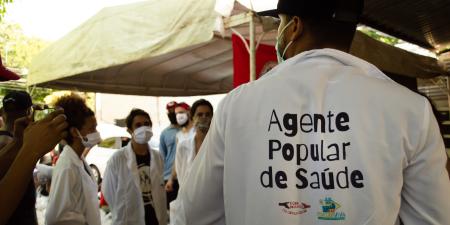Abstract
Migrants along the US-Mexico border have been subjected to transnational violence created by international policy, militaristic intervention, and multinational organizational administration of border operations. The COVID-19 pandemic compounded migrants’ vulnerabilities and provoked several logistical and ethical problems for US-based clinicians and organizations. This commentary examines how the concept of transnational solidarity facilitates analysis of clinicians’ and migrants’ shared historical and structural vulnerabilities. This commentary also suggests how actions implemented by one organization in Tijuana, Mexico, could be scaled more broadly for care of migrants and asylum seekers in other transnational health care settings.
Case
During the COVID-19 pandemic in 2020, a woman we call SR, an asylum seeker from Honduras accompanied by her 3-year-old daughter, was waylaid in Tijuana, Mexico, in a crowded congregate facility housing 100 migrants, some of whom had already tested positive for the SARS-CoV-2 virus. By mid-April 2020, the state of Baja California in Mexico had registered 500 COVID-19 cases and 50 deaths,1 but a protocol had not yet been established to manage outbreaks in migrant shelters, and Tijuana’s hospital was quickly overwhelmed.
Feeling ill, SR arrived at a free clinic for migrants in Tijuana with low oxygen saturation and a fever. Dr N, a volunteer at the clinic from the United States, reviewed SR’s symptoms and test results and diagnosed SR with COVID-19.Resources available to Dr N and other clinicians trying to respond to their increasing numbers of migrant patients seriously ill with COVID-19 were limited, and several clinic staff members who practiced in the United States were prohibited by their San Diego, California-based employers from traveling outside the United States, even just a few miles over the border. The number of clinicians allowed to travel and care for migrant patients across this border diminished daily. Clinicians were deeply troubled by their employers’ travel and clinical practice restrictions, and they struggled to decide how they could and should respond.
Commentary
The clinic to which SR presents is managed by a binational organization, Refugee Health Alliance (RHA), based in Tijuana, Mexico,2 which offers free health services to members of migrant communities in Baja California. Its founders believe that protecting the well-being of migrants—especially asylum seekers like SR—arriving at the US-Mexico border is a responsibility of US-based clinicians. As discussed below, the clinic embraces an ethic of transnational solidarity in response to enduring, diverse forms of violence that migrants face when crossing international borders.
Transnational Solidarity in Practice
Transnationalism is a widely used framework in the social sciences wherein the nation-state is not the primary unit of analysis.3 Ramón Saldívar, for example, uses the notion of a “transnational imaginary” to describe the “construction of new spaces for the enactment of politics outside the realm of the purely national.”4 According to Saldívar, migrants and those inhabiting borderland spaces between, outside, and across nation-state borders consistently develop and redefine a transnational perspective. We therefore suggest that many clinicians providing care to migrant communities in borderland regions have also developed a transnational perspective of a “shared fate” with the patients they serve.4
Solidarity, another concept with a long lineage in the social sciences, has been described as the feeling and practice of cohesion between individuals and groups.5,6 Solidarity is undergirded by a common understanding of the mutual interests, responsibilities, and benefits that derive from membership in a social group or coalition. Solidarity can be enacted across categories of social difference through actions that aim to support or advocate for those disproportionately affected by systemic inequalities. Such practices of solidarity differ from acts of charity in their recognition of the histories and social structures that produce and maintain these inequalities.7
Transnational solidarity is a foundation of US-based clinicians’ social responsibility to deliver care along international borders, in contrast to global medical humanitarianism efforts deployed, for example, by nongovernmental organizations like Médecins Sans Frontières8—with its focus on attending to individuals’ biomedical needs even across contested nation-state borders—and the International Committee of the Red Cross—with its explicit commitment to political neutrality.9 Transnational solidarity expresses an understanding of shared global histories that have produced recent transnational migrations and reinforced border militarization10,11,12,13 and expresses opposition to US government efforts to restrict entry to, sanction, or punish asylees and migrants.14,15 Transnational solidarity as an ethical value also expresses medical neutrality, the view that patients must have unobstructed access to health services regardless of citizenship status or cultural, national, or political background.16
Transnational solidarity conceived in this way calls upon clinicians to recognize how social forces and inequities produce patterns of what some scholars and advocates call “structural vulnerability” among patients in borderland regions.17,18 Structural vulnerability, a concept from the medical social sciences, considers how individuals often relegated to the bottom of social, political, and economic hierarchies experience disproportionately negative health outcomes.19 International borders themselves can also produce or exacerbate structural vulnerability among certain individuals and groups, such as irregular migrants and asylum seekers, who face disproportionate targeting, policing, deportation, detention, and exploitation during migration.20 Medical care and advocacy for patients like SR thus necessitate engagement outside formal clinical spaces and on both sides of international borders—perhaps even in violation of institutional policies.
For example, although Dr N’s employer, a US safety-net hospital, prohibited its clinicians from pursuing international travel, Dr N provided pro bono care in Tijuana. Because Dr N’s clinical care is grounded in an ethical framework that seeks to redress long-standing transnational harms and inequities that affect migrants’ health, clinicians and organizations must work at border sites to bring necessary care and material support to patients lacking international mobility and access to care. In short, health care and advocacy are not sans frontières, but transpire because of and in direct response to border militarization and bureaucratization practices that harm migrants.
Responses to Transnational Violence
Asylum seekers along the US-Mexico border have long been subjected to transnational violence brought about by US economic, foreign, and immigration policies as well as by various powerful multinational organizations—from drug cartels to agricultural companies.3,21,22 These forces are transnational in that they operate across multiple national borders, and they have harmed people in several countries throughout Latin America. As we elucidate below, viewing this continuing violence through a transnational lens demonstrates how the harms that SR faces are rooted in the US government’s historical involvement in Latin America and contemporary practices of migrant deterrence.23,24,25,26
Clinicians can challenge the stigmatization of migrants by interrogating their own negative biases when providing care to migrants.
SR’s home country, Honduras, has been a site of perpetual US intervention since the early 20th century.27 For decades, Honduras’ economic and political system have been largely controlled by American-owned agricultural companies, and dozens of US military interventions have been aimed at preserving their commercial interests.10,11,13
In recent years, Central America has become a primary drug trafficking route, following US interdiction efforts in the Caribbean.21,22 In Honduras, these efforts have resulted in escalating violence perpetrated by powerful local gangs with well-known connections to police and some political leaders.28 Many asylees have fled as a result of widespread human rights abuses under the Honduran government, which continues to have the support of the US government.29,30
SR, Dr N’s patient, arrived in Tijuana with her 3-year-old daughter in 2018, after she was threatened with violence by a local gang. With the support of a legal advocacy organization, she began the process of applying for asylum in the United States. However, in January 2019, the US Department of Homeland Security (DHS) implemented the Migrant Protection Protocols (MPP).31 The MPP contravened established domestic and international refugee law by sending asylum seekers like SR back to Mexico to await resolution of their court proceedings, placing them at increased risk for victimization by local gangs, transnational drug cartels, and Mexican security officials.32 In the wake of the COVID-19 pandemic, asylum trials were postponed, leaving many asylees indefinitely stranded in Mexico.33
In addition to DHS implementing the MPP, in August 2021 the Centers for Disease Control and Prevention (CDC) issued an order under Sections 362 and 365 of the Public Health Services Act,34 which allows border agents to immediately expel migrants attempting to cross into the United States, often preventing them from making an asylum claim. Ostensibly aimed at defending against the spread of COVID-19, the order flouted international human rights laws and bolstered anti-immigrant rhetoric and a crackdown on the asylum system.35,36 Meanwhile, due to US pressure, the Mexican government has taken increasingly heavy-handed approaches to asylees.37,38 Since implementing these policies, many along the US-Mexico border have had to stay in crowded, underresourced shelters or makeshift camps while awaiting court dates.39 These migrants are also often denied health care in public facilities.40
Forging Transnational Solidarity
Although Dr N was prohibited from international travel by his employer, he continued to travel given the urgent needs experienced by asylum seekers and a recognition of the US government’s role in amplifying the harms they experienced. Some clinicians’ supervisors support efforts like Dr N’s, though perhaps begrudgingly. RHA, which manages the clinic employing Dr N, required its clinicians to follow CDC guidelines to reduce risk of transmitting SARS-CoV-2. RHA’s work demonstrates how transnational solidarity can help clinicians and organizations navigate ethically complex health care along politically fraught borders. Clinicians can work in solidarity with migrants in some of the following ways.
Challenge the stigmatization of migrants. Anti-immigrant rhetoric and policies have stigmatized migrants—especially migrants who do not qualify for asylum—and who, as a result, may be perceived as being less deserving of quality medical care.41,42 Clinicians can challenge the stigmatization of migrants by interrogating their own negative biases when providing care to migrants. Health professions educators can help students overcome stigmatization by training them in social medicine frameworks, such as structural competency, that acknowledge the impact of US policies on migrant health.43,44
Provide in-person or telehealth care to migrants with limited access to services. Many organizations are working tirelessly to provide medical care, whether in person or virtually, to migrants and asylees in border regions. Recognizing that many clinicians may not have sympathetic supervisors, Dr N has begun to work with others to organize telemedicine consultations with the support of volunteers in Tijuana. Asylum seekers also must often undergo forensic medical examinations to support their cases. Medical student-run initiatives,45 such as the asylum clinic launched by the Los Angeles Human Rights Initiative,46 provide opportunities for clinicians to conduct pro bono forensic evaluations.45,46 Practitioners should explore similar initiatives in their localities or, if none exist, launch their own.
Channel critical resources across and along borders. RHA’s clinicians drew upon their networks to deliver important resources across the border, even during a pandemic that restricted clinicians’ travel and work. They also mitigated the compounded risks experienced by asylees by supporting shelters in implementing public health measures. For example, Dr N worked with other clinicians and organizations to raise funds so that SR could stay quarantined in a hotel room to reduce further spread of COVID-19 at her shelter. With the support of its network, RHA then installed handwashing stations at several shelters and distributed donated personal protective equipment and diagnostic instruments to shelter directors. Through maintaining robust communication with shelters, doctors were able to diagnose several people with COVID-19 and request support from local public health authorities. Clinicians should consider the material and knowledge-based resources they can access through their networks in order to make those resources accessible to vulnerable communities at the border. Supporting COVID-19 vaccine distribution to migrant communities is also urgent.
Challenge immigration policy that incurs harm and undermines clinical neutrality. For example, RHA collaborates with legal organizations seeking to overturn the MPP and CDC order and has joined efforts to protest the inadequate—and at times harmful—health care provided to asylum seekers in US detention centers.47,48,49 These important partnerships seek to intervene in transnational harm. Thus, the ethics of transnational solidarity guiding the RHA’s work serves as a source of creative intervention, collaboration, and commitment to health equity.
References
-
Fry W, Mendoza A. “A war zone”: Tijuana hospitals overwhelmed by coronavirus patients. San Diego Union Tribune. April 10, 2020. Accessed February 17, 2022. https://www.sandiegouniontribune.com/news/border-baja-california/story/2020-04-10/a-war-zone-tijuana-hospitals-overwhelmed-by-coronavirus-patients
-
Refugee Health Alliance. Accessed December 3, 2021. https://www.refugeehealthalliance.org/
-
Basch L, Schiller NG, Szanton Blanc C. Nations Unbound: Transnational Projects, Postcolonial Predicaments and Deterritorialized Nation-States. Gordon & Breach Science Publishers; 1994.
-
Saldívar R. The Borderlands of Culture: Américo Paredes and the Transnational Imaginary. Duke University Press; 2006.
-
Holmes SM. As societies re-open in this pandemic, we need social solidarity to survive the summer. BMJ Opinion blog. April 30, 2020. Accessed December 3, 2021. https://blogs.bmj.com/bmj/2020/04/30/seth-holmes-societies-re-open-pandemic-need-social-solidarity-survive/
-
Durkheim E. The Division of Labor in Society. Free Press; 1933.
- Spade D. Solidarity not charity: mutual aid for mobilization and survival. Soc Text. 2020;38(1):131-151.
-
Redfield P. Life in Crisis: The Ethical Journey of Doctors Without Borders. University of California Press; 2013.
-
Forsythe DP. A new International Committee of the Red Cross? J Hum Rights. 2018;17(5):533-549.
-
Langley L, Schoonover T. The Banana Men: American Mercenaries and Entrepreneurs in Central America, 1880-1930. University Press of Kentucky; 1995.
-
Grandin G. Empire’s Workshop: Latin America, the United States, and the Rise of the New Imperialism. Owl Books; 2007.
-
Zilberg E. Space of Detention: The Making of a Transnational Gang Crisis Between Los Angeles and San Salvador. Duke University Press; 2011.
-
Chomsky A. Central America's Forgotten History: Revolution, Violence, and the Roots of Migration. Beacon Press; 2021.
-
Schoenholtz AI, Ramji-Nogales J, Schrag PG. The End of Asylum. Georgetown University Press; 2021.
- Slack J, Heyman J. Asylum and mass detention at the US-Mexico border during Covid-19. J Lat Am Geogr. 2020;19(3):334-339.
-
Hall P. Medical neutrality. J R Soc Med. 1999;92(11):553.
- Hernández-Rosete Martínez D, Sánchez Hernández G, Pelcastre Villafuerte B, Juárez Ramírez C. Del riesgo a la vulnerabilidad. Bases metodológicas para comprender la relación entre violencia sexual e infección por VIH/ITS en migrantes clandestinos. Salud Ment. 2005;28(5):20-26.
- Quesada J, Hart LK, Bourgois P. Structural vulnerability and health: Latino migrant laborers in the United States. Med Anthropol. 2011;30(4):339-362.
- Bourgois P, Holmes SM, Sue K, Quesada J. Structural vulnerability: operationalizing the concept to address health disparities in clinical care. Acad Med. 2017;92(3):299-307.
-
Carruth L, Martinez C, Smith L, Donato K, Piñones-Rivera C, Quesada J; Migration and Health in Social Context Working Group. Structural vulnerability: migration and health in social context. BMJ Glob Health. 2021;6:e005109.
-
Bunck J, Fowler M. Bribes, Bullets, and Intimidation: Drug Trafficking and the Law in Central America. Pennsylvania State University Press; 2012.
-
Bagley BM, Rosen JD. Drug Trafficking, Organized Crime, and Violence in the Americas Today. University Press of Florida; 2015.
- Saldaña-Portillo MJ. The violence of citizenship in the making of refugees: the United States and Central America. Soc Text. 2019;37(4):1-21.
- Alberto C, Chilton M. Transnational violence against asylum-seeking women and children: Honduras and the United States-Mexico border. Hum Rights Rev. 2019;20(2):205-227.
-
De León J. The Land of Open Graves: Living and Dying on the Migrant Trail. University of California Press; 2015.
-
Jusionyte I. Threshold: Emergency Responders on the US-Mexico Border. University of California Press; 2018.
-
Pine A. Working Hard, Drinking Hard: On Violence and Survival in Honduras. University of California Press; 2008.
-
Frank D. The Long Honduran Night: Resistance, Terror, and the United States in the Aftermath of the Coup. Haymarket Books; 2018.
-
Pine A. Revolution as a care plan: ethnography, nursing and somatic solidarity in Honduras. Soc Sci Med. 2013;99:143-152.
- Frank‐Vitale A, d’Aubuisson JJM. The generation of the coup: Honduran youth at risk and of risk. J Lat Am Caribb Anthropol. 2020;25(4):552-568.
- Kocher A. Migrant Protection Protocols and the death of asylum. J Lat Am Geogr. 2021;20(1):249-258.
- Silverstein MC, Long RFP, Burner E, Parmar P, Schneberk TW. Continued trauma: a thematic analysis of the asylum-seeking experience under the Migrant Protection Protocols. Health Equity. 2021;5(1):277-287.
-
Narea N. The US has abandoned asylum seekers in Mexico during the pandemic. Vox. May 13, 2020. Accessed February 17, 2022. https://www.vox.com/2020/4/27/21232808/asylum-seekers-mexico-coronavirus-trump
-
Extension of order under sections 362 and 365 of the Public Health Service Act; order suspending introduction of certain persons from countries where a communicable disease exists. Fed Regist. 2020;85(78):22424-22427.
-
Sandhu M. Unprecedented expulsion of immigrants at the southern border: the Title 42 process. Harv Law. December 26, 2020.
-
Hampton K, Heisler M, Pompa C. Neither safety nor health: how Title 42 expulsions harm health and violate rights. Physicians for Human Rights. July 28, 2021. Accessed September 30, 2021. https://phr.org/our-work/resources/neither-safety-nor-health/
- Goodman A. The human costs of outsourcing deportation. Humanity. 2017;8(3):527-529.
- Vogt W. Dirty work, dangerous others: the politics of outsourced immigration enforcement in Mexico. Migr Society. 2020;3(1):50-63.
-
Blue SA, Devine JA, Ruiz MP, et al. Im/mobility at the US-Mexico border during the COVID-19 pandemic. Soc Sci (Basel). 2021;10(2):47.
- Basok T, Wiesner MLR. Precarious legality: regularizing Central American migrants in Mexico. Ethn Racial Stud. 2018;41(7):1274-1293.
- Willen SS. How is health-related “deservingness” reckoned? Perspectives from unauthorized im/migrants in Tel Aviv. Soc Sci Med. 2012;74(6):812-821.
-
Holmes SM, Castañeda E, Geeraert J, et al; Migration and Health in Social Context Working Group. Deservingness: migration and health in social context. BMJ Glob Health. 2021;6:e005107.
-
Metzl JM, Hansen H. Structural competency: theorizing a new medical engagement with stigma and inequality. Soc Sci Med. 2014;103:126-133.
- Harvey M, Neff J, Knight KR, et al. Structural competency and global health education. Glob Public Health. 2022;17(3):341-362.
- Gu F, Chu E, Milewski A, et al. Challenges in founding and developing medical school student-run asylum clinics. J Immigr Minor Health. 2021;23(1):179-183.
-
Los Angeles Human Rights Initiative. Accessed February 17, 2022. https://lahumanrights.org
- Holmes SM, Hansen H, Jenks A, et al. Misdiagnosis, mistreatment, and harm—when medical care ignores social forces. N Engl J Med. 2020;382(12):1083-1086.
-
Halevy-Mizrahi NR, Harwayne-Gidansky I. Medication confiscation: how migrant children are placed in medically vulnerable conditions. Pediatrics. 2020;145(1):e20192524.
- Ghandakly EC, Fabi R. Sterilization in US Immigration and Customs Enforcement’s (ICE’s) detention: ethical failures and systemic injustice. Am J Public Health. 2021;111(5):832-834.



